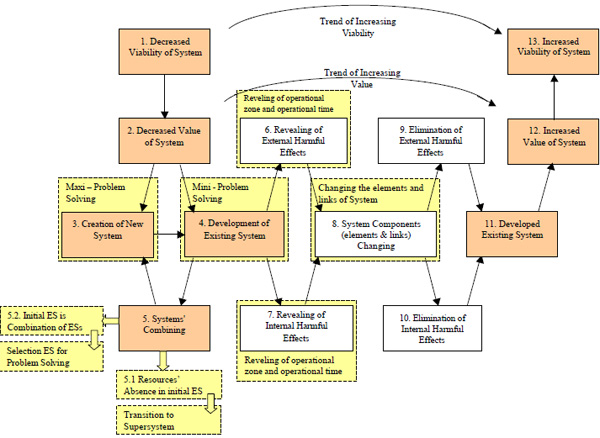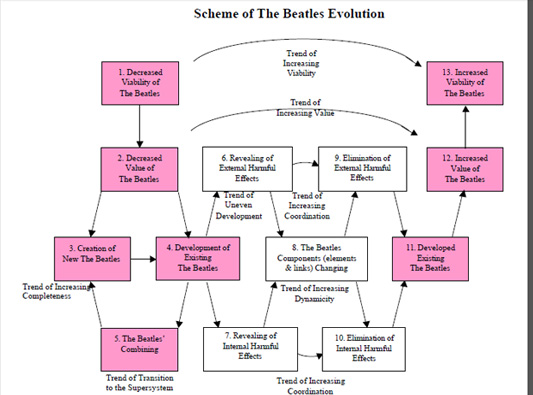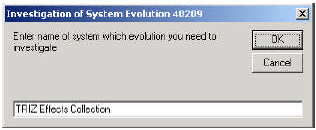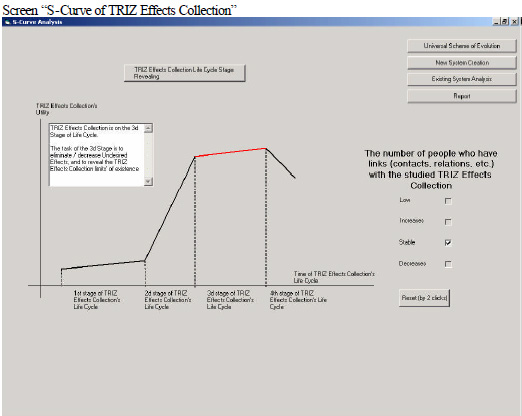Universal Scheme of Evolution – Theory and Practice
Editor | On 18, Jun 2004
The transdisciplinary unification within the sciences can most fruitfully take evolution as the basic concept. The theory will describe the various phases and facets of the evolutionary process with invariant general laws. The laws will enable investigators to describe the behavior and evolution of quanta, and of the atoms, molecules, cells, organisms, and systems of organisms that evolve from quanta, in reference to a self-consistent unified scheme. Laszlo, Ervin. The Foundations of Transdisciplinary United Theory.1
Abstract
A Universal Scheme of Evolution is presented, and explained by numerous examples of systems.A Universal Scheme of Evolution is based on the universal Trends of Evolution, revealed in TRIZ.
Part I. Basis for Universal Scheme of Evolution
The TRIZ crisis indicators:
1. Growing theory’s (growth of number of elements) complexity at the absence of generally accepted structure.
2. The critique of existing TESE list
2.1. The well-known and escalating number of facts about real systems’ evolution that are presented in TRIZ in no way:
*Survival and non-survival (i.e. death) of systems are the most fundamental phenomena! If to consider definition of the law,2 this definition concerns to a survival and non-survival of systems first of all.
* Methods of genetic algorithm and evolutionary programming. Today numerous users of evolutionary approaches develop huge amount of systems practically in any field of science and technology.
2.2. Some trends are excluded out of list:3
* Trend of Increasing Elimination of System Components (Trimming). In reality it’s a formulation of Trend of Increasing Dynamicity by means the reduction of number of insufficient elements of System with goal to increase the System value.
*Trend of Increasing Efficiency of Substance, Energy, and Information Flows. It’s a formulation of Trend of Increasing Ideality by means of Trend of Increasing Dynamicity of flows.
2.3. The list is restructured. Increasing Coordination of the System is only possible by means of Increasing Dynamicity of the System, and Increasing Dynamicity of the System is possible by means of Transition to the Micro Level, or Elimination of Human Involvement, or Increasing (Decreasing) number of System Components
3. Divergences in approaches: TRIZ theorists and practitioners have huge amount of different looks onto theory structure and projects’ roadmaps. The analysis of huge amount of documents (1995 – 2003), which reflect real activity of systems’ development, has shown full absence of a generality of approaches: there are different sets of theory elements, different and constantly varying order of elements in lists, absence of hierarchy or infringement of hierarchy in lists.4
4. Absence of unified terminology: there are still no common terms for basic elements of theory
5. Growth of criticism TRIZ from the developers, teachers, and TRIZ-community
5.1. Kozhevnikova L. The review of questionnaires of members “TRIZ-FORUM”5 … TRIZ now is out of development rise. The certain recession is observed. It is visible through quantity and quality of new publications; through the quantity of inquiries from TRIZ Fund Materials that has considerably decreased; attenuation of interest to TRIZ on the part of teachers is observed, and it is after rough rise in the beginning of the nineties; TRIZ centers in different cities do not work. TRIZ-movement in many respects has lost its unity.
5.2. Korolev V. The analysis of a problem “Introduction TRIZ into Pedagogics”6 At last it was offered to use the TRIZ itself for the solution of TRIZ problems. But there was the only bad fact that the problem was stated indistinctly. The doubt is caused by the declared strategy of TRIZ positioning as the “normal science”. As means of achievement of this purpose rather trivial inventions such as participation in conferences and so forth are assumed.
5.3. Petrov V. The Future of the TRIZ.7 The different parts TRIZ duplicate each other and there is no unambiguity in use of TRIZ tools.
5.4. Toru Nakagawa, et al. Reorganizing TRIZ Solution Generation Methods
As a methodology TRIZ offers a large number of techniques and principles: they include 40 Principles of Invention, 76 Standards of Inventive Solutions, Trends of Evolution of Technological Systems, Separation Principle, etc. This shows the richness and outstanding strength in TRIZ. However, such a huge body of methods and knowledge bases is not easy to understand and even confusing for learners of TRIZ. Thus, unfortunately, the penetration of the Russianborn TRIZ into the West since 1990s has been much slower than being anticipated by TRIZ enthusiasts.
5.5. Robert Orlean. More comments on “If TRIZ is so good…â€9 The reason why TRIZ is hard to sell is that you are selling TRIZ. The grim reality of the business world is that we measure success in financial terms, not in terms of how clever our innovation is. Therefore, focusing on a methodology (however clever or potent) is irrelevant to the scorekeeping of complete relevance is the business result that TRIZ deliver.
5.6. Darrell Mann. TRIZ For Everyone (Even Those Who Don’t Want To Spend A Year Learning It)10 … thinking about the spread and use of TRIZ. We can bludgeon people until they submit, or we can recognize that everyone is different, learns in different ways and wants different things. We can force them to do it our way, or allow them sufficient slack to adapt TRIZ (and indeed other tools, methods, and philosophies) to suit their particular differences. One is more likely to succeed than the other. One is harder work than the other.
5.7. James Kowalick. Problem-Solving Systems: What’s Next after TRIZ?11 The use of ARIZ is highly effective. But if ARIZ is to be judged by the same criteria with which we judge other technical procedures, it has to be stated “ARIZ is a very complex system that is not easy to learn in a relatively short time.” … the very “best” systems are not overly complex, nor are they overly difficult and timeconsuming to learn. In this sense, they are “elegant” systems. The response to this challenge must be “simplify the system,” and that’s precisely what TRIZ developers and instructors have been doing over the past several decades.
Believing that the trends of Engineering System Evolution is the basis of theory, there is need to present clearly the links between separate trends, to demonstrate the trends’ wide distribution throughout the all TRIZ tools. The solid system of Trends of Engineering System Evolution (TESE) will allow:
*To forecast the development of theory itself,
* To make the TESE use more consistent
* To make the teaching of TRIZ methodology more uniform: up for today the trends
hierarchy and even the set of trends is arbitrary
Universal Scheme of Evolution
With the help of numerous examples of systems’ development, on the base of well-known TRIZ trends of evolution, a Universal Scheme of Evolution was developed. USE allows seeing even the method of trials-and-error; the TRIZ tools itself in the absolutely new light. USE will help to summarize TRIZ community efforts, can to become the basis for accelerated TRIZ development.
The article “A Universal Scheme of Evolution†was published under title “The Uniform Scheme of Evolution.†in The Second Annual AI TRIZ Conference Proceedings TRIZCon 2000, p. 183; April 30 – May 2, 2000. Nashua, New Hampshire.
Box 1. Decreased Viability of System
It means the identification of a problem in the analyzed System that decreases its viability. From our point of view it expresses our uncertainty if the System will survive in a future or not. Box 1 corresponds to formulation of Altshuller administrative contradiction: “It does need to do something to change (and save) System, but it is unknown what has to be done.”
Box 2. Decreased Value of System
It means the revealing of System’s decreased value, where the value is the ratio of System’s useful and harmful functions. After System’s value evaluation we can go along two different ways:
Box 3. Creation of New System
If the System with necessary functions does not exist at all, or if the analyzed existing System doesn’t have resources for needed changes, i.e. for needed improvement. Box 3 corresponds with the Trend of Increasing Completeness:
* Presence of necessary components (elements and links) * Minimal functionality of components (elements and links).
Box 4. Development of Existing System
If the analyzed existing System has resources for needed changes, i.e. for needed improvement.
Box 5. Combining Systems
As a rule one uses this way when at least one of two Systems doesn’t have resources for improvement. By this way we reveal the opportunities of combining Systems. Combining Systems may be the similar; with a difference in the same characteristics, including alternative Systems; different Systems at all; System and anti-System. The number of combined Systems: bi-Systems, poly-Systems. Then it is natural transition from the box 5 to the box 3 because new System with the new system quality is created. Having satisfied the Trend of Increasing System Completeness this new System begins a new cycle of development as existing one. It is shown by transition from box 3 to box 4.
Boxes from 1 to 5 show one complete cycle of existing System development, or System creation and subsequent development. Boxes from 11 to 13 show the result of this development. Boxes from 6 to 8 show the detailed mechanism of System development. Boxes from 6 to 8 may be hidden into box 4, and boxes from 9 to 10 – into box 11.
Box 6. Revealing of External Harmful Effects (undesirable effects)
Search of external harmful effects between System’s components (elements and/or links) and Supersystem. The splitting of the set of harmful effects into external and internal subsets is very important. In search of external harmful effects before internal ones the Trend of Uneven Development of System Parts12 is displayed.
Box 7. Revealing of Internal Harmful Effects (undesirable effects)
Search of internal harmful effects between System’s components (elements and/or links).
Box 8. Modification of System Components (elements and links) Box 8 corresponds with the Trend of Increasing Dynamicity, which is realized by:
* The quantitative and/or qualitative changes of elements and/or links — transition from rigid elements to elements with hinges and elastic, transition from Macro- to microlevel, by elimination of human involvement
* Changes of System properties – reliability, maintainability, productivity, and etc.
* Changes of temporal processes in the System — transition to periodic, pulsation, resonant, and similar processes; transition to properties with a time gradient.
* Spatial changes in the System — transition to properties, for example, weight, density, temperature, conductivity, to chemical properties with a spatial gradient. Mentioned changes of System components may be performed with contradiction appearance and its solution, or without contradiction.
Box 9. Elimination of External Harmful Effects (undesirable effects)
Statement that the external harmful effects had disappeared, or these harmful effects had lost their importance, or these harmful effects’ action has become not rather critical.
Box 10. Elimination of Internal Harmful Effects (undesirable effects)
Statement that the internal harmful effects had disappeared, or these harmful effects had lost their importance, or these harmful effects’ action has become not rather critical. The passes from Box 6 to Box 9, and from Box 7 to Box 10 correspond to the Trend of Increasing Coordination.
Box 11. Improvement of the Existing System
Statement that the System is developed as a whole.
Box 12. Increased value of System
Statement that the System’s value is increased. The pass from Box 2 to Box 12 corresponds to the Trend of Increasing Ideality.
Box 13. Increased Viability of System
Statement that the System viability is increased. The pass from Box 1 to Box 13 corresponds to the Trend of Increasing Viability. As a result of one development cycle the System gets advantages in relation to non-modified Systems or Systems with lower value; the developed System is being used further, i.e. its survives on the market.
Conclusion for Part I
How do new kinds of animals spring up? 13 Because of action of various mutagen factors new attributes appear. In the huge majority of cases, they are useless or even harmful. Moreover, very rare the attribute is useful for organism. Natural selection rejects individuals with unsuccessful new attributes and promotes preservation and distribution of individuals with useful attributes.
The traditional mechanism of work on the inventive problems is the same. Inventors without knowledge about trends of engineering systems development, generate – mentally or in metal – a number of various variants of the decision.14 Only those “mutations” is viable which act in a direction of objectively existing trends of engineering systems development.15 The Nature does not have consciousness, does not have intellect: results of “mutations” are not studied; struggle for increase of “interest of successful mutations” is not conducted. In technology there is an opportunity to save up experience of “mutations”, to investigate it, to reveal “rules of successful mutation”, which reflect the objective trends of engineering systems development. It will allow carrying out “mutation” knowingly: the first suggested variant should be the best.
Criteria for the selection of theories16 It is better if its sphere of application is broader and if it can make more predictions. Thus, the criterion of the generality and predictive power of a theory is the primary one for comparing theories. A second criterion is simplicity; because theories are models intended for use by people they are obviously better when they are simpler to use.
If we investigate which theories have actually been preferred because of their simplicity, we find that the decisive reason for acceptance has been neither economic nor esthetic, but rather what has often been called “dynamic.” This means that the theory was preferred that proved to make science more “dynamic,” i.e., more fit to expand into unknown territory. The esthetic criterion or the criterion of the beauty of a theory … is difficult to defend as one independent of other criteria. However, it becomes very important as an intuitive synthesis of all the above-mentioned criteria. To a scientist a theory seems beautiful if it is sufficiently general and simple and he feels that it will prove to be dynamic.
Part II. Fields of USE approach
Methodology
First, the USE approach allows a new looks onto methodology of systems’ investigation and modifying. This methodology is a core of everything, because the mankind over its history only creates, investigates, and modifies the myriads different systems, nothing more. The historically first method of system creation, investigation, and modification is Trial-and- Error Method (TEM). Let us see, how this TEM correlates with Universal Scheme of Evolution.
Universal Scheme of Evolution and Trial-and-Error Method
Practically in Trial-and-Error Method only 3 boxes of Universal Scheme of Evolution remain.
Box 1. The System that is threatened by “mortal†danger if the solution to change System will not be found in reasonable time and reasonable expenses.
Box 8. Variants of System development (modification) to save System
Box 13. The saved modified System.
It is absolutely correlates with the problem solving by means of Trial-and-Error Method, when the different possible configurations are generated, after a test of their “fitness”, the good ones are retained, and the bad ones or “errors” are eliminated.17 Trial and error method has a number of negative features:
* Trial and error makes no attempt to discover why a solution works, merely that it is a solution
* Trial and error makes no attempt to generalize a solution to other problems
* Trial and error is an attempt to find a solution, not all solutions, and not the best solution
It was shown that with TESE System approach to non-algorithmic methods of creativity the activation methods use the logic of TESE System, at least, the origin problem in the formulation “We need to do something†and the final one “We will do thatâ€. The heretical conclusion was made – all methods of systems’ transformation have the same nature and logic! Creativity Activation Methods (Brainstorming, Morphological Analysis, Synectics, etc.). Not far from Trial-and-Error Method the creativity activation methods as Brainstorming, Morphological Analysis, Synectics, etc., exist. Some differences between TEM and these methods are as follows:
* More systematic procedure (session)
* The imagination agitation
* The leading questions, etc.
In spite of some positive features, the matter of these methods remains the same – the psychology, and not the objective trends of systems’ evolution. Because of non-principal difference with TEM the same 3 boxes of USE describe these methods. TRIZ On the base of TESE System, the unity of TRIZ tools is shown:
* Altshuller matrix (The Table of principles to solve engineering contradictions)
* System of standard solutions (Su-Fields’ System) to solve inventive problems
* Algorithm of Inventive Problem Solving
Altshuller Matrix
The comparison of Universal Scheme of Evolution and Altshuller Matrix shows that the use of it is the analysis of Engineering System (ES) in accordance to Trends of Evolution but only in nondirect form.
The procedure of Altshuller Matrix use is as follows:
· In vertical column of Altshuller Matrix is chosen the parameter that ought to be changed (improving feature);
· In horizontal row of Altshuller Matrix is chosen the inadmissibly changing parameter (worsening parameter) because of the first parameter changing;
· At the intersection of vertical column and horizontal row is placed the box with inventive principles, which are recommended for resolution of revealed contradiction. Why does it need to change parameter? The parameter is being changed if and only if, when the undesirable effect between ES and its supersystem, or inside ES, appears. It means that the external or internal discoordination (undesirable, harmful effect) is being found.
To eliminate the discoordination it is need to change some element or link in ES. It is important to emphasize the wide meaning of element or link change, i.e. the dynamization of ES component. The dynamization is the increase of possibility of Engineering System for purposeful (goal directed) changes, which provide the better adaptation to changing environment, to conditions of functioning.18
If there are no obstacles to component change (dynamization), it means the absence of inventive problem at all. However, if in case of necessary change of component the undesirable (harmful) effect arises, it is qualified as the contradictive situation. We resolve the contradiction by use of the recommended principles in Altshuller Matrix.
Anyway, having changed the ES component, i.e. having removed an external or internal discoordination, we get the advanced (coordinated) ES. It means increase of ES ideality, and in its turn, increase of ES viability.
Standards
The existing Standards Set is compared with Universal Scheme of Evolution. At the highest hierarchical level, the Standards Set was not changed; the structure of Sub-Sets was developed to a certain extent in accordance with USE logics.
The Sub-Set «Creation and Distraction of Su-Field Systems» directly fits Box 2 «New System Creation» of the Universal Scheme of Evolution.
There is the suggestion: to divide Sub-Set 3 «Transition to Supersystem and to microlevel» in 2 parts and redistribute these parts between boxes 5 «Transition to Supersystem» and 8 «System Components Changing».
Universal Scheme of Evolution and Standards’ Set

Algorithm of Inventive Problem Solving (ARIZ)
Boxes “Decreased Viability of System†and “Decreased Value of System†are absent in ARIZ. The fact of the ARIZ use, which is a method of analysis and development of initial system, means, that this system should be improved. Formally, the estimation of ideality of the original system is performed at the information stage of Value and Engineering Analysis (VEA).
Boxes “Creation of New System†and “Development of Existing System†correlate with two directions in ARIZ: transition to new design (maxi-problem solving) and transition to
development of existing system (mini-problem solving).
Boxes “Revealing of External Harmful Effects†and “Revealing of Internal Harmful Effects†correlate with two steps in ARIZ: reveling of operational zone (step 2.1.) and operational time (step 2.2.) of conflict.
Box 8 “System Components (elements & links) Changing†correlates wit h Parts 4 and 5 of ARIZ. Both USE (Box 5, sub-box 5.1) and TRIZ (Part 6, step 6.4.) suggest the decision when the analyzed system does not have resources to perform required function. In this situation, it needs to combine the analyzed system with another one, which can perform the mentioned function with the help of resource of the latter.
Both USE (Box 5, sub-box 5.2) and TRIZ (Part 6, step 6.2.) suggest the decision when the analyzed system is the combination of two Engineering Systems. In this situation, it needs to choose only one ES, and go through the USE again.
Really, the ARIZ is the process of step-by-step processing of inventive problems, where the trends of engineering system evolution are included into structure of this process, or act like specific working tool. Therefore, the correct solution by means of ARIZ it’s a directed development the engineering system in accordance of with trends of evolution.
Any natural science theory is the Engineering System, which is carrying out the function: to translate one kind of knowledge about any real objects into another kind of knowledge.20 On the base of such Altshuller vision and with the help of “The Structure of Scientific Revolution†book by T.Kuhn, the hypothesis is suggested and proved: a Universal Scheme of System Evolution properly describes the evolution of science (theory or paradigm).
Genetic Algorithm, Evolutionary Programming and Artificial Intelligence The developed Universal Scheme of Evolution in its structure is similar to well-known Genetic Algorithm approach. The entire research area of Genetic Algorithms, as well as that of Evolutionary Programming, was inspired by Darwin’s theory of natural selection and survival of the fittest. Genetic algorithms are problem-solving programs that solve problems through processes such as reproduction, mutation, and natural selection of solutions. A Universal Scheme of Evolution is developed on the base of trends of Engineering Systems evolution. From this point, their incredible similarity grows.
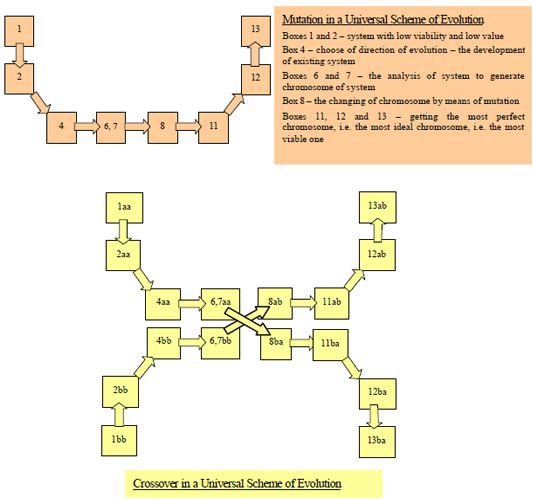
The automated problem-solving technique of genetic programming has generated at least 36 human-competitive results (21 involving previously patented inventions). It also covers two automatically synthesized controllers for which the authors have applied for a patent and includes examples of an automatically synthesized antenna, classifier program, and mathematical algorithm. As computer time becomes ever more inexpensive, researchers will start routinely use genetic programming to produce useful new designs, generate patentable new inventions, and engineer around existing patents.21
If assume that the intelligence is the ability of program to reflect the trends of surrounded world, and to use this knowledge to gain system’s goals, then in case when the program actively interacts with its environment, it has the elements of intelligence, and acts in accordance with USE algorithm.
The Beatles phenomenon is the example of musicians’ band evolution. It is the especially interesting example, because the evolution is continuing more than 30 years after break-up! The Beatles were changing constantly:
* Songs themes – from “silly love songs†to loneliness and fear feelings, to human life and society goals
*Music forms – from primitive rock-n-roll to symphony
* Music roots (place and time) – from European tradition to Indian sound; from modern tunes to the past centuries’ baroque melodies.
The Beatles were changing constantly:
* Songs themes – from “silly love songs†to loneliness and fear feelings, to human life and society goals
* Music forms – from primitive rock-n-roll to symphony
* Music roots (place and time) – from European tradition to Indian sound; from modern tunes to the past centuries’ baroque melodies
* Band structure and functions – from singer and backing group to polyphony of voices and instruments
* Recording technique – from some takes on 2-4 tapes recorder to multiple tapes, loops and back record, special effects, feedback, fade-ins, chaotic tape montage
* Song composing process – from 2 step process “composing – record†to composing during the record session
* LP conception – from set of separate songs to integral musical conception It needs to emphasize, that all these changes22 were not the answers on moods and wishes of listeners. The Beatles were changing all these fields beforehand, surpassing the spiritual demands, even not formed yet. The group did not survive in the ordinary sense; they were preventing the fall of auditorium interest…
Part III. USE Software
Editor’s note: This software is not available-the author uses it for testing the USE. We have included it in the article because it demonstrates the USE method. Please do not request the software from The TRIZ Journal or from the author. A computer software system is developed for presentation of Universal Scheme of Evolution in application to specific system, which evolution software user needs to investigate.
The software’s purposes are:
* To show by means of self-consistent unified scheme the universality of evolution of any system – from atoms and molecules up to cells, organisms (systems of organisms), from engineering systems and non-engineering ones – science, society and civilization, art, religion, and etc.
* To give an opportunity to software user to reveal in his/her unique system: o The cause of low system’s survivability because of the low system’s ideality, i.e. the low ratio «system’s utility / costs of utility»; o The universal stages of system evolution – birth and low development stage, fast development stage, maturity stage, stage of declination and death;
* To deliver to the software user the specific directions and methods of system’s development (new system creation or/and current system development), which are coordinated with stages of system evolution and with value of ratio «system’s utility / costs of utility». Universal Scheme of Evolution software gives opportunities:
* Presenting unity of different types of systems;
* Presenting the invariance of methods of investigating and changing of system of different natures;
* Compare classical list of TESE and Trends in Universal Scheme of Evolution;
* Revealing the stage of life on S-Curve diagram, and the most adequate direction of system development in the specific stage;
* To fulfill the structural analysis of the system;
* Finding and analyzing the harmful (non-desirable) effects, developing “cause-and-effect†pairs of harmful (non-desirable) effects, developing the “cause-and-effect†network of harmful (non-desirable) effects for entire system. The goal of “cause-and-effect†network development is the revealing of key harmful (non-desirable) effect(s);
* Choosing the direction of development to eliminate revealed key harmful (non-desirable) effect(s). Let’s investigate like an example the evolution of TRIZ Effects Collection. It’s interesting from two points of view:
* It would be one more test for Universal Scheme of Evolution logic, and
* The possible useful forecast for “TRIZ Effects Collectionâ€
Here all possible directions of evolution for systems of any type (natural, social, productive, technical, scientific, etc.) are presented. The specific system can be developed as a new one, or as an existent one, or it will be rejected by the more successful system.
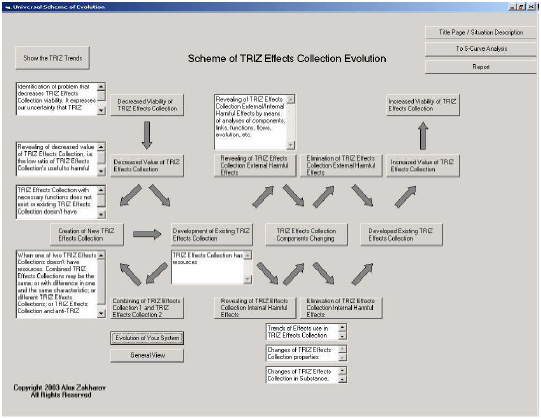
To choose the specific direction of evolution it’s need to find the stage of Life Circle of TRIZ Effects Collection

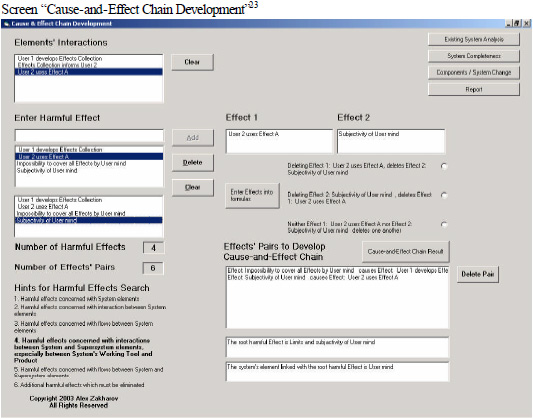
The main non-desirable effect is use of User mind. Rules of box # 8 of Universal Scheme of Evolution require:
* Elimination of revealed key harmful (non-desirable) effect – the human elimination out of system
* Searching and inclusion the new effects into Effects Collection without human engaging
* The solving problem (design, components, function) controls by Effects Collection The revealed portrait of solution leads to concept of on-line Effects Collection that includes:
* The searching machine that surf through Internet to find and collect information about Effects (in scientific publication, patents, etc.)
* The programmed Scheme of evolution. The more possibilities of programmable USE:
* In case of impossible development because of appeared contradiction, there is an opportunity to use the Table to choose principles of engineering contradiction resolution (Altshuller matrix);24
* Developing the statement for every link of the chain «need à function à principle of operation à design», and test the logic of every such statement;
* Developing the structure of system, and to test system in accordance with completeness demand, to analyze the internal and external connections to find the harmful (non-desirable) effects;
* Presenting and analyze systems’ combining.
* Automated report generating The making of operable USE software is another one argument, that in TRIZ was discovered the essential core, the universal structure, which truly reflects the evolution of any system.
Conclusions From the start of USE development, the goal was formulated as «To design the logic scheme of Trends of Evolution that were well-known in TRIZ.» This initial problem is solved. However, the additional results were ensued: * The more deeper understanding of TRIZ matter as general, and its structure and elements particularly
* The further possibility of TRIZ approach
* The possibility to find the universal language between specialists of very different fields of knowledge
* The possibility to develop TRIZ education
* And so on, and so on, and so on… Now only the borders of knowledge about systems we want to investigate, is limit.
Alex Zakharov
May 10, 2004
Boston, Massachusetts, USA






